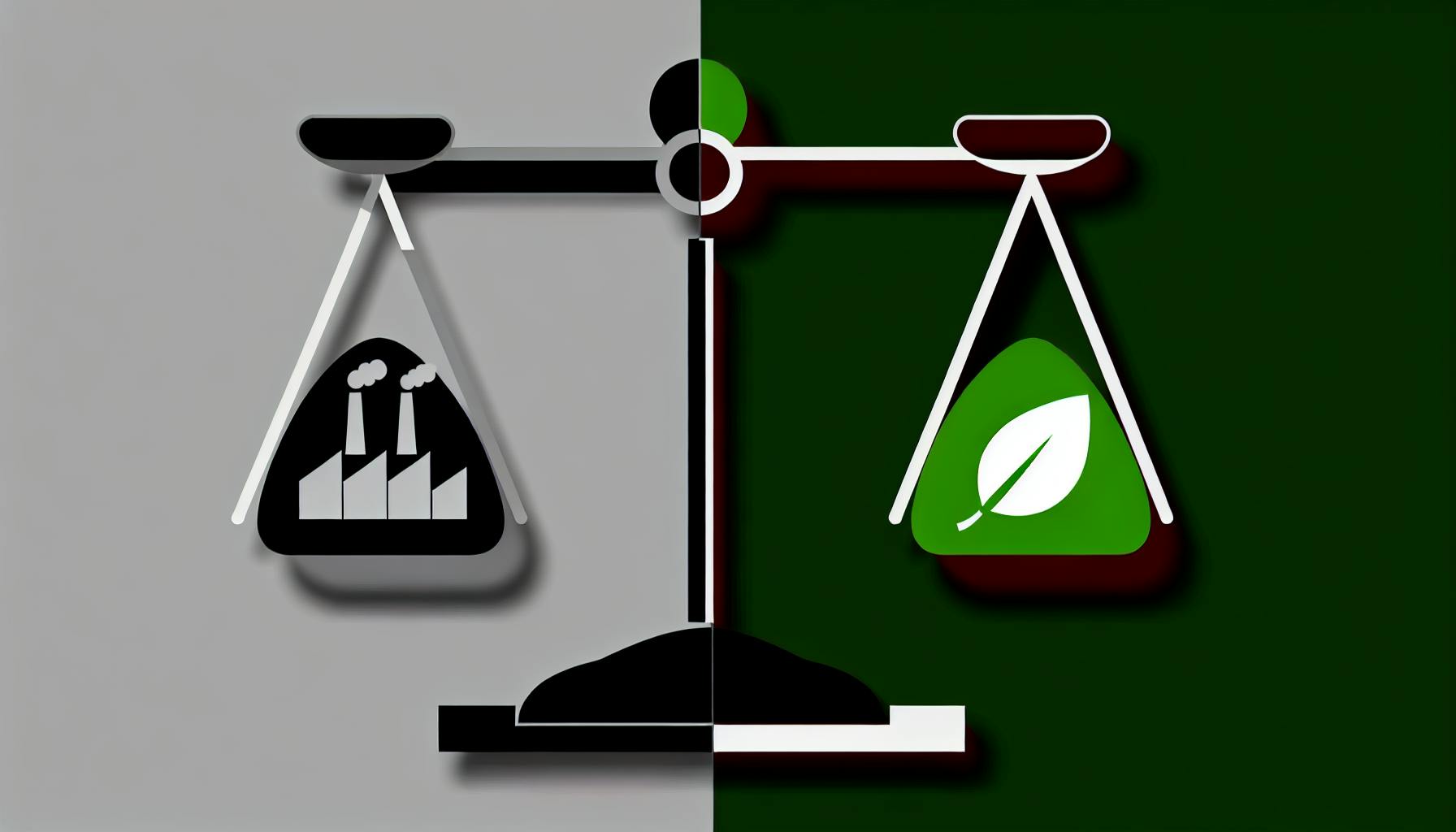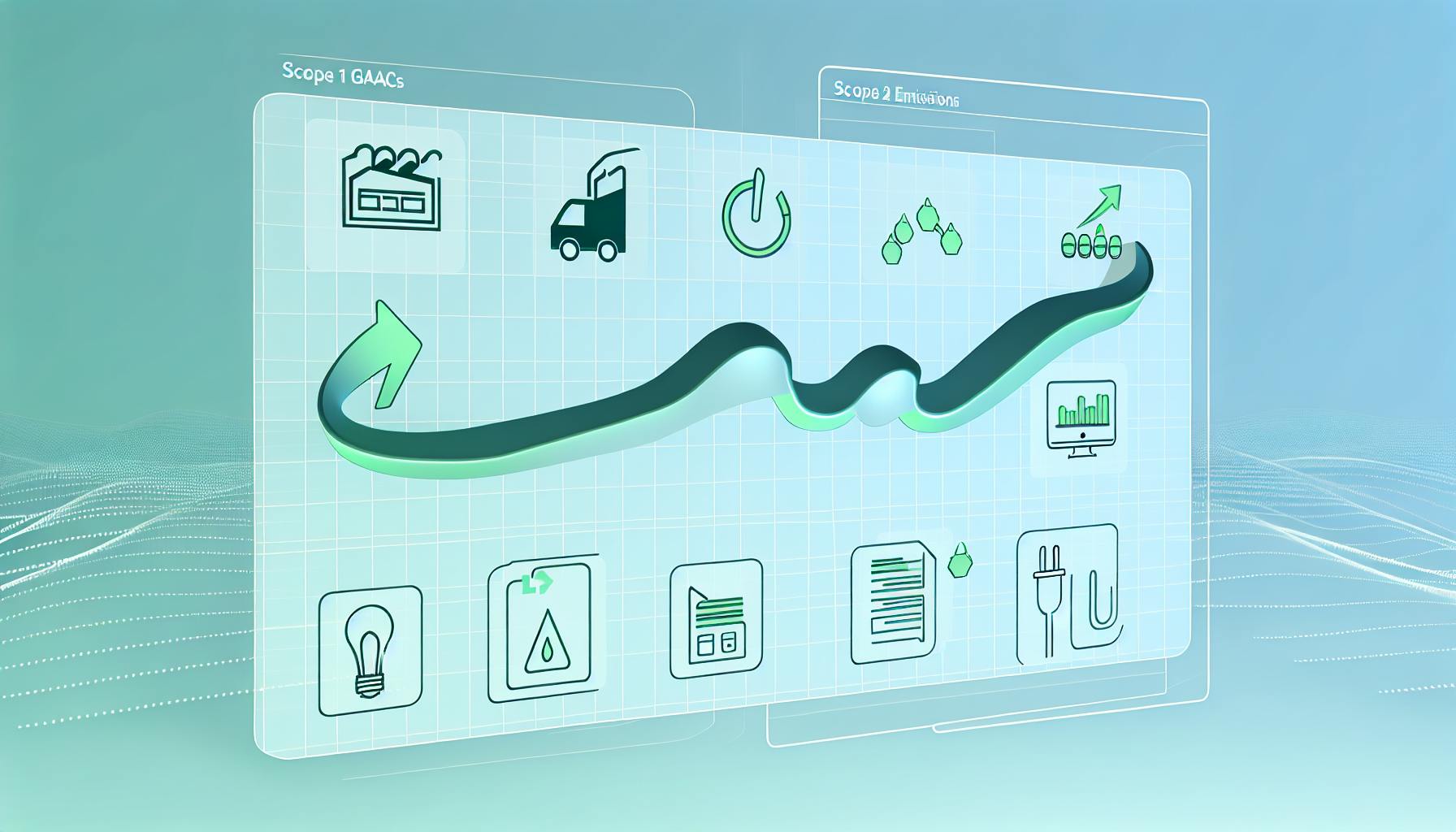As an SME, streamlining carbon accounting practices can be an intimidating endeavor.
This guide promises to demystify the complex GHG Protocol, offering simplified, step-by-step advice tailored for SMEs looking to improve their sustainability efforts.
You'll discover the core principles of accurate carbon accounting, learn how to establish a GHG framework aligned with global best practices, and leverage data-driven insights to inform strategic business decisions. Embrace this practical GHG Protocol training to efficiently communicate your organization's green narrative.
Streamlining GHG Protocol for SMEs
The GHG Protocol is considered the global standard for measuring and reporting greenhouse gas (GHG) emissions from private and public sector operations. However, its extensive guidelines can be daunting for small and medium enterprises (SMEs) to implement. This article breaks down the key aspects of GHG Protocol tailored for SMEs looking to improve their carbon accounting practices.
Implementing GHG Protocol not only allows SMEs to accurately measure their carbon footprint, but also demonstrates climate responsibility to stakeholders. By streamlining GHG Protocol principles, SMEs can seamlessly integrate carbon accounting into their business processes without getting overwhelmed.
Understanding the GHG Protocol Standard
The GHG Protocol classifies direct and indirect emissions into three scopes to avoid double counting:
- Scope 1 covers direct emissions from sources owned or controlled by the company, like fuel combustion and manufacturing processes.
- Scope 2 accounts for indirect GHG emissions from purchased electricity consumed by the company.
- Scope 3 includes other indirect emissions across the company's value chain.
For SMEs starting their net-zero journey, measuring Scope 1 and 2 emissions are a practical first step aligned with GHG Protocol guidelines. As capabilities grow, Scope 3 emissions can be added for full value chain transparency.
GHG Protocol also requires identifying specific GHGs including carbon dioxide, methane, nitrous oxide, and fluorinated gases. While carbon dioxide typically accounts for the largest share, calculating other GHGs provides a complete emissions profile.
Principles of Accurate Carbon Accounting
The five reporting principles of GHG Protocol ensure high quality, consistent results:
- Relevance: Measure GHG sources, data, and methodologies appropriate to business goals and stakeholder needs.
- Completeness: Capture all emissions sources within the inventory boundary. Disclose and justify any exclusions.
- Consistency: Use standardized methodologies to allow meaningful performance tracking over time.
- Transparency: Address relevant issues openly and coherently to allow external review.
- Accuracy: Reduce uncertainties as much as possible and avoid systematic errors or biases.
SMEs should thoroughly assess emissions sources to account for their largest impacts while balancing data collection efforts through the principles of relevance and completeness.
By following GHG Protocol guidelines tailored for SME capacities, companies can derive actionable insights on reducing their carbon footprint and credibly communicating sustainability efforts.
What are the 5 principles of GHG Protocol?
The GHG Protocol provides comprehensive guidance on measuring and managing greenhouse gas emissions. Adhering to its core principles ensures your emissions inventory gives a true and fair representation of your company's climate impact.
Relevance
Focus your emissions calculations on sources directly influenced by your operations and activities. Prioritize including emissions sources in proportion to their size and environmental impact.
Completeness
Account for all relevant emission sources and activities within the chosen inventory boundary. Properly justify any exclusions to avoid underreporting.
Consistency
Use consistent methodologies and data collection approaches across your operations and over time. This allows for accurate performance tracking and meaningful comparisons.
Transparency
Address all relevant issues openly and thoroughly in your inventory reports. Disclose any exclusions, estimations, or uncertainties to provide clarity.
Accuracy
Ensure emission calculations and reports are systematically neither over nor under actual values. Use GHG Protocol-aligned primary data and emission factors whenever possible.
Following these principles demonstrates commitment to best practices in sustainability reporting. Reliable data builds trust with stakeholders expecting climate accountability.
What is the GHG Protocol?
The GHG Protocol is a set of guidelines and standards developed to help businesses measure and report their greenhouse gas (GHG) emissions. Understanding your carbon footprint using methods like the GHG Protocol is the critical first step for any business aiming to reduce their climate impact.
For smaller businesses just getting started on the journey towards net-zero emissions, navigating these guidelines can feel daunting. But have no fear - with a bit of effort, any SME can utilize the GHG Protocol to get an accurate picture of their total carbon emissions.
Here's a quick overview of the key concepts and calculations behind GHG Protocol carbon accounting:
- The GHG Protocol separates emissions into three "scopes" - Scope 1 covers direct emissions from owned or controlled sources like vehicles and equipment. Scope 2 covers indirect emissions from purchased electricity and heat. Scope 3 includes all other indirect emissions from the upstream and downstream value chain.
- To calculate your carbon footprint, you'll need to identify emission sources in each scope, gather activity data like fuel or electricity usage, choose appropriate emissions factors, and multiply the data by the factors. Online calculators and carbon accounting software can help automate this process.
- The standard outlines specific guidelines on things like setting organizational and operational boundaries, tracking emission reductions over time, and accounting for offsets or renewable energy certificates (RECs).
While the GHG Protocol does have a learning curve, it provides the globally recognized standard for credible and consistent emissions reporting. Investing time to understand the methodology now will pay dividends as stakeholders demand increased transparency around climate impacts. Leveraging purpose-built software solutions can further simplify the process for resource-constrained SMEs.
With the right guidance and tools, the GHG Protocol provides a powerful framework for businesses to kickstart their net-zero journeys. Tracking emissions allows you to identify "hot spots" to target for reductions, communicate progress to stakeholders, and benchmark against peers - ultimately enabling more ambitious and accountable climate action.
What are the 7 gases in GHG Protocol?
The GHG Protocol tracks emissions across seven major greenhouse gases that contribute to climate change. These include:
- Carbon dioxide (CO2)
- Methane (CH4)
- Nitrous oxide (N2O)
- Hydrofluorocarbons (HFCs)
- Perfluorocarbons (PFCs)
- Sulphur hexafluoride (SF6)
- Nitrogen trifluoride (NF3)
Understanding emissions across these GHGs is key for developing robust GHG inventories. You can also use the GHG Protocol guidance to further streamline your carbon accounting and ensure compliance. The accurate tracking and reporting on these seven gases can help your company engage in more meaningful climate action.
What is the GHG measurement protocol?
The Greenhouse Gas Protocol (GHG Protocol) is the most widely used international standard for measuring and reporting greenhouse gas emissions. It was launched in 2001 as a partnership between the World Resources Institute (WRI) and the World Business Council for Sustainable Development (WBCSD).
The protocol establishes best practices for businesses, governments, and other organizations to accurately calculate and report their emissions footprint. By providing standardized guidance, it enables meaningful comparisons across companies and helps drive climate action through reliable data.
Some key points for SMEs to understand about the GHG Protocol:
- It categorizes emissions into three scopes:
- Scope 1 covers direct emissions from owned or controlled sources (e.g. vehicles, industrial processes, facilities).
- Scope 2 covers indirect emissions from purchased electricity, heating, and cooling.
- Scope 3 includes up/downstream emissions from the extended value chain.
- The recommended approach is for SMEs to initially measure Scope 1 and 2 emissions as a priority, while Scope 3 can be added over time.
- The protocol outlines reporting principles such as relevance, completeness, consistency, accuracy, and transparency. Adhering to these ensures robust carbon accounting.
- Free supporting materials are available like calculation tools, reporting templates, best practice guidance, and training.
By leveraging the GHG Protocol, SMEs can effectively measure and benchmark their carbon footprint. This enables tracking of emission trends, identification of hotspots, goal setting, and communication with stakeholders regarding climate action progress.
sbb-itb-919600f
Establishing Your GHG Protocol Framework
The GHG Protocol provides a comprehensive, globally recognized framework for measuring greenhouse gas (GHG) emissions. For small-to-medium enterprises (SMEs), navigating this framework can seem daunting initially. However, following a step-by-step approach can simplify the process.
Defining Scope 1: Direct Emission Responsibilities
Scope 1 covers direct GHG emissions from sources owned or controlled by your company. This includes emissions from:
- Stationary combustion of fuels in boilers, furnaces, etc.
- Mobile combustion of fuels in company vehicles
- Industrial process emissions
- Fugitive emissions from refrigerants, etc.
To calculate your Scope 1 emissions, first take an inventory of all your organization's owned or controlled emission sources. Then, collect activity data on the amount of fuels burned or materials consumed. Finally, use published emissions factors to convert activity data into total emissions. Relevant GHG Protocol calculation guidance is available covering different source types and industries.
For SMEs, Scope 1 emissions typically represent the bulk of an organization's carbon footprint. Getting accurate measurements here is crucial. Tools like ecohedge.com">EcoHedge can automate data collection and GHG calculations, ensuring consistency with GHG Protocol methodologies.
Decoding Scope 2: Indirect Emission Insights
Scope 2 covers indirect GHG emissions from purchased electricity, steam, heating, and cooling. Although your company does not directly emit these GHGs, they occur in the production of energy you consume.
As per GHG Protocol Scope 2 Guidance, you should account for Scope 2 emissions using one of two approaches:
- Location-based: Calculates emissions using average energy production emission factors for the grids where your electricity consumption occurs. Easy to derive but does not account for renewable energy purchases.
- Market-based: Calculates emissions based on emissions factors from electricity suppliers you have chosen. Better reflects renewable energy procured but involves more complex data collection.
Most SMEs take the location-based approach initially. However, as more companies source renewable power, market-based accounting allows better tracking of these sustainability efforts.
Gathering Data for Scope 3: The Value Chain Challenge
Scope 3 emissions encompass all other indirect emissions across your value chain. This includes emissions from:
- Purchased goods/services
- Transportation providers
- Waste disposal
- Investments
- Leased assets
- Franchises
- And more
Scope 3 reporting is not yet mandatory but allows a fuller view of your carbon impact. However, tracing indirect emissions along entire supply chains can be extremely complex for SMEs. Doing so involves gathering activity data from all upstream and downstream partners along your value chain.
Start by checking suppliers and service providers for existing emissions data. For others, use industry emissions factors as estimates. Over time, engage key stakeholders to provide accurate footprint data. Tools like EcoHedge help consolidate value chain data for Streamlined Scope 3 tracking.
Following structured GHG Protocol guidance makes building a robust GHG inventory achievable even for SMEs with limited resources. From foundational Scope 1 and 2 maps to complex value chain analyses, take one step at a time on your sustainability journey. Reliable carbon accounting is the first step toward meaningful climate action and net zero progress.
GHG Protocol Calculation Guidance: Making Sense of Emissions Data
For small and medium enterprises (SMEs), calculating carbon emissions can seem daunting. The Greenhouse Gas (GHG) Protocol provides comprehensive global standardized frameworks for measuring greenhouse gas (GHG) emissions, but the extensive methodology can be complex for SMEs to navigate. This article offers simplified guidance on GHG Protocol calculations tailored for SMEs ready to take climate action.
Emission Factors Decoded for SME Use
Emission factors are values that enable organizations to estimate their GHG emissions based on activity data. For example, an emissions factor could specify the CO2 emitted per kilowatt-hour of electricity used. Some key points for SMEs on emission factors:
- Where to find: Emission factors are often published by government bodies or industry associations. For instance, the EPA provides U.S. emission factors. The GHG Protocol also offers emission factor guidance.
- Industry-specific factors: Using industry-specific emission factors, when available, leads to more accurate calculations aligned with an SME's operations. Generic emission factors can serve as defaults.
- Updates over time: Emission factors may change yearly as grids add more renewables or technology improves. SMEs should check for updated factors annually. Free tools like EcoChain handle updates automatically.
- Units of measurement: Pay attention to units when entering activity data and selecting emission factors to ensure accurate math. Common units are kg CO2e per kilowatt-hour (kWh) for electricity or kg CO2e per gallon for transportation fuels.
With a basic understanding of emission factors, SMEs can identify and use the most relevant, up-to-date factors for their industry and location to calculate emissions following GHG Protocol guidelines. Check out the next section for tools that simplify the entire calculation process.
Tools and Templates: Practical GHG Protocol Calculation Assistance
Specialized tools and templates provide user-friendly ways for SME staff to accurately carry out GHG Protocol calculations without getting overwhelmed by spreadsheets.
Reporting templates like the GHG Protocol's SME template automate emission factor lookups and calculations after an SME inputs their activity data. Easy-to-update dropdown lists help select the most current factors.
Carbon accounting platforms like EcoHedge go further by completely automating data collection across utility bills, fuel expenditures, and other sources to instantly generate reliable emissions numbers. These tools track changing emission factors and data over time, ensuring SMEs have access to accurate, up-to-date emissions data.
By relying on simple but powerful tools for GHG Protocol calculations, SME staff bypass manual spreadsheet work so they can focus on analyzing results and taking actions to reduce emissions.
Deep Dive: Enhancing GHG Accounting Accuracy
As SMEs embark on their sustainability journey, accurately measuring and reporting GHG emissions is crucial to benchmark performance, set credible reduction goals, and communicate progress with stakeholders. However, compiling a robust GHG inventory that adheres to GHG Protocol guidance can prove challenging at times. This section offers practical tips to refine GHG accounting practices for optimal accuracy.
Navigating Uncertainties with Precision
Uncertainty is inherent in carbon accounting. However, SMEs can significantly minimize uncertainties by:
- Prioritizing data collection for emission sources with higher contribution
- Using primary data from utility bills and sensors over secondary sources
- Performing regular validation through meter calibrations and data reviews
- Conducting sensitivity analysis to determine data quality tolerance thresholds
For instance, by regularly tracking and validating electricity usage data from smart meters, SMEs can virtually eliminate uncertainty for a top Scope 2 emission source.
Similarly, sensitivity analysis allows businesses to gauge emission variances from estimation methods and data inaccuracies. By testing different scenarios, SMEs can define data quality thresholds that provide an acceptable level of precision for sound decision making. This prevents overinvesting effort in perfect accuracy.
Assurance and Verification: Securing Inventory Integrity
Independent verification offers external confirmation that a company's GHG inventory and reporting adheres to GHG Protocol guidance. However, for resource-constrained SMEs, alternatives like self-verification checks allow reasonably ensuring inventory integrity at lower costs.
Helpful self-verification steps include:
- Documenting data collection and GHG calculation methodologies
- Performing qualitative assessment of uncertainties
- Conducting peer reviews of inventory process and data samples
- Comparing inventory metrics year-on-year to identify anomalies
- Benchmarking emission performance trends against sector averages
By institutionalizing such verification practices internally, SMEs can secure inventory integrity per GHG Protocol standards without prohibitive third-party assurance costs.
Utilizing GHG Inventory for Strategic Business Decisions
Companies today face mounting pressure from investors, customers, and regulators to address sustainability and demonstrate concrete climate action. An accurate greenhouse gas (GHG) emissions inventory provides the foundation for strategic decisions to reduce your environmental impact and communicate your sustainability initiatives effectively.
By leveraging emissions data through GHG accounting software like EcoHedge, small and medium enterprises (SMEs) gain actionable insights to set targeted reduction goals, prioritize high-impact initiatives, track performance over time, and showcase transparency through comprehensive reporting.
Targeting Emissions Reductions with Scientific Precision
An emissions inventory as per the GHG Protocol allows you to identify the largest contributors to your carbon footprint. With this baseline established, you can:
- Set emissions reduction targets aligned with climate science using methods like the Sectoral Decarbonization Approach (SDA). This brings goals within your reach based on your sector's realities.
- Detect high-impact quick wins like switching to renewable energy or reducing business travel emissions.
- Track emissions over time and demonstrate quantifiable reductions for each action taken.
- Forecast future emissions and adjust strategies dynamically based on actual performance.
EcoHedge Lifecycle empowers SMEs by automating target-setting aligned with the latest climate research. Its intuitive dashboards make decarbonization tangible - facilitating data-backed decisions for maximum emissions cuts.
Communicating Your Green Narrative: Transparency in Reporting
Stakeholders today expect authenticity and transparency when evaluating a company's sustainability claims. Comprehensive GHG reporting as per GHG Protocol guidance builds trust and gives your climate action the credibility it deserves.
With EcoHedge software, SMEs can efficiently:
- Produce GHG reports covering all relevant Protocol Scopes and categories.
- Export presentation-ready reports to showcase to stakeholders like investors and clients.
- Gain stakeholder buy-in by demonstrating commitment through emissions disclosures.
- Build climate resilience and future-proof business strategies via sustainability communications.
By making GHG reporting simple and accessible for SMEs, EcoHedge drives the transparency needed to accelerate our collective climate progress.
Embracing GHG Protocol Training and Reporting: A Summary for SMEs
Adopting the GHG Protocol to measure and report emissions can seem daunting for small and medium enterprises (SMEs). However, with the right guidance and tools, the process can be greatly simplified.
Here are some key steps SMEs should take to implement the GHG Protocol successfully:
Essential Tips to Navigate GHG Protocol Training
- Leverage automated software like EcoHedge to calculate emissions according to GHG Protocol guidelines. This eliminates manual data collection and calculations errors.
- Consult reporting templates like the ones offered by EcoHedge to easily compile and format your emissions data.
- Take online courses focused specifically on GHG Protocol training for SMEs, like this course offered by EcoHedge.
- Read GHG Protocol Scope guidance to understand what emission sources need to be included. Focus on Scope 1 and 2 to start.
- Use secondary keywords such as "GHG Protocol calculation guidance" and "GHG Protocol Standard" to find more tailored advice.
By embracing the wealth of resources available and integrating the right tools into your workflows, SMEs can overcome the complexities of GHG accounting. Taking a phased approach and seeking targeted advice enables continual progress on sustainability reporting.



.png)


